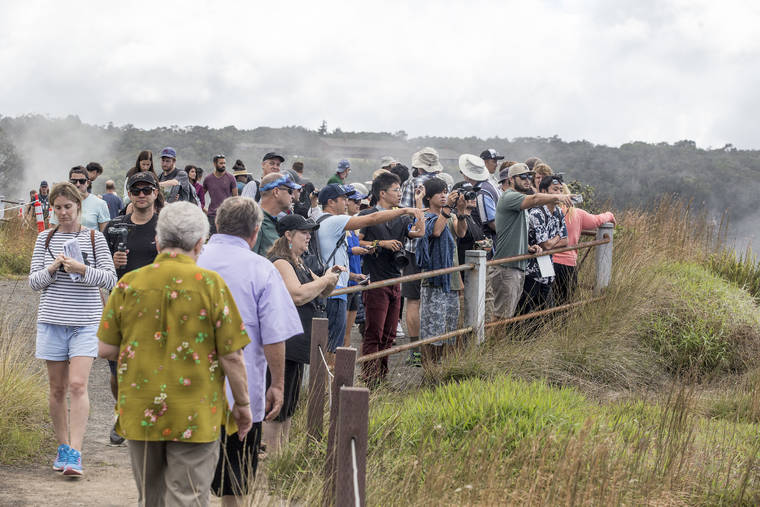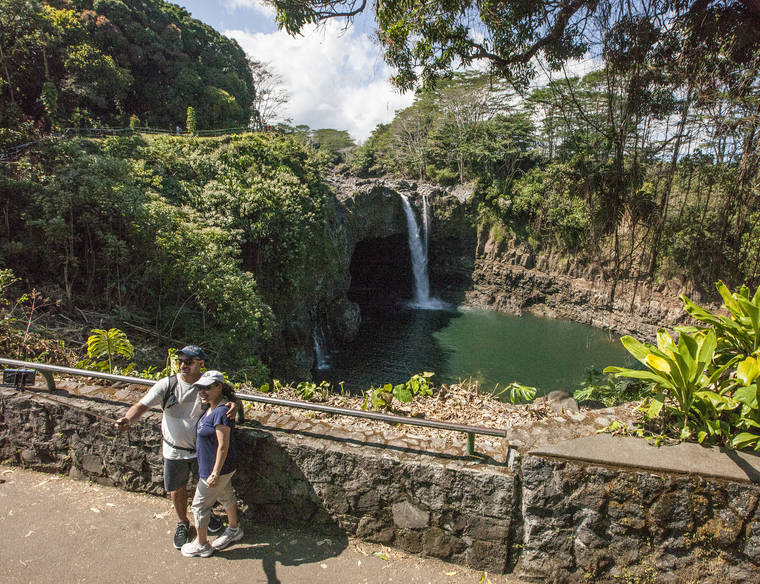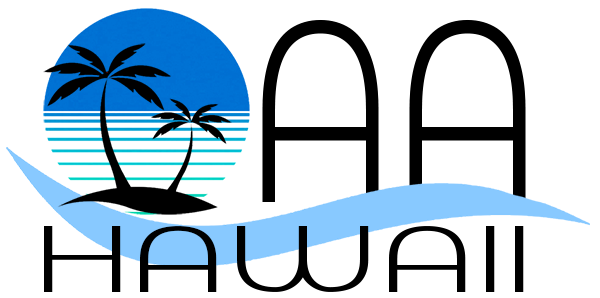By Stephanie Salmons Hawaii Tribune-Herald | Tuesday, August 4, 2020, 12:05 a.m.
Share this story
-

Visitors see how Halemaumau crater expanded during the 2018 reopening of Hawaii Volcanoes National Park. (Hawaii Tribune-Herald/File Photos)
-

Tribune-Herald file photo Tourists take a selfie in front of Rainbow Falls in 2019 in Hilo.
-
Hawaii County last week released its five-year strategic tourism plan, a guiding document to help ensure responsible tourism that respects the Big Island’s communities and natural and cultural resources.
The county gathered input from more than 400 representatives from the visitor industry, community, and public and private sectors while developing the plan, which “carries forward the idea that successful tourism starts with a high quality of life for residents … and sets it as the vision for the future of Hawaii Island.”
ADVERTISING
The plan itself has four goals — responsible tourism, pono-based visitor communication, place-based education for residents and infrastructure — and each goal has a number of objectives and outlines actions to achieve those.
For instance, for responsible tourism, the plan calls for the development of an inventory of cultural practices and natural resource areas, identifying those that are appropriate for visitors to access and the creation of plans to sustain those resources.
It also calls for communities to retain their sense of place by integrating Native Hawaiian practitioners as leaders within the visitor industry; encouraging visitors and incentivizing companies to buy local goods and services by providing technical support for local businesses that want to promote or further develop their products and services in the visitor industry; and identifying and reducing barriers that prevent visitor industry companies from buying Hawaii Island products.
The plan also proposes to develop ways for visitors to “authentically engage” and give back to the Big Island, while being accountable for their actions.
To address place-based education for residents, the county should work to further develop training programs to share Hawaiian culture and history with those working within the visitor industry, according to the plan.
Additionally, the plan recommends the development of a program that recognizes and rewards employees and volunteers within the visitor industry for acquiring greater knowledge of Hawaiian culture, history and pono practices.
And among other actions, the plan also calls for the county to identify solutions for the lack of affordable workforce housing and to identify areas to address resident and visitor safety.
Building on a previous plan, Hawaii County began its update more than a year ago, prior to the onset of the COVID-19 pandemic, which “dramatically changed the economy, especially the visitor industry.”
Riley Saito, deputy director of the county Research and Development Department, said that before COVID-19, which has largely halted the influx of travelers to the state and Big Island, tourism was growing but put a lot of strain on the island’s natural resources.
Saito said the new plan addresses pre-COVID concerns that the county needed to somehow change its relationship with tourists and how they interact with the community, the land and natural resources.
Declining visitors and stay-at-home orders issued in the early days of the pandemic provided a glimpse of how resources can be revitalized with the absence of people.
“… We do understand tourism is the economic engine for this island, and if we could, (we would) welcome the tourists and change their experience to be one of a higher interaction with the host culture and host people,” Saito said.
The plan states that before COVID-19, the number of residents who completely agreed that tourism “brought more benefits than problems” dropped by 24% between 2010 and 2019, and there was a 5% increase in the number of residents who felt the island was being run for tourists at the expense of local people.
In Hawaii County, the number of visitors in March 2020 declined 53% compared to March 2019, according to data provided in the plan. In April, the county recorded just 705 arrivals.
According to the plan, COVID-19 disrupted positive forecasts for both visitor arrivals and expenditures, and current studies forecast a “dramatic decrease” in visitor arrivals next year, which “paints an uncertain picture of the industry’s future.”
An estimated 3.4 million arrivals are expected across the state this year, but tourism isn’t expected to return to levels experienced in 2019 until 2025, and that’s only if several factors prove true.
“This period presents many uncertainties around how the visitor industry will be redeveloped, however, it may also alleviate some of the negative sentiments from residents and create an opportunity to revisit how some experiences are delivered to visitors,” the plan states.
According to the plan, the current decline in visitors allows for a more “responsible approach” to tourism, centering around place and residents.
Saito said a slow return of tourism means the county will be able to better implement many elements of the strategic plan.
“When you have a plan, if you’re doing it with the island at 80% occupancy, (it can) be very difficult to implement,” he said. “As tourism ramps up, it’s a slow growth. We can actually transform and pivot the plan as needed as the growth occurs.”
Ross Birch, executive director of the Island of Hawaii Visitors Bureau, said the plan is “really predominantly on the side of managing tourism rather than marketing tourism.”
According to Birch, the visitors bureau is looking at using the strategic plan to manage high levels of visitors, but post-COVID-19, the plan can be used to “bring back visitation properly and potentially create new jobs and new opportunities associated with visitation to the island.”
According to Saito, the county already has started outreach to different community groups.
ADVERTISING
For more information or to see the full plan, visit bit.ly/HawaiiCoTourism.
Email Stephanie Salmons at ssalmons@hawaiitribune-herald.com.

